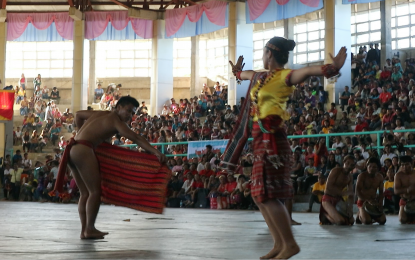
Performers from the seven towns and one city in Kalinga vie for the best performance award of the 'digdiga ni tupayya' (courtship dance) during the 24th foundation day and 3rd Bodong festival in the province. (Photo courtesy of Jamie Joie Malingan/PIA-CAR)
BAGUIO CITY-- The Department of Tourism (DOT) in the Cordillera Administrative Region (CAR) is hoping to have Kalinga's courtship dance, "digdiga ni tupayya", included on the United Nations Educational, Scientific and Cultural Organization (UNESCO) intangible cultural heritage list.
"The 'digdiga ni tupayya' is an old tradition of courtship dance that involves the whole community," DOT-CAR officer-in-charge Jovita Ganongan said on Friday.
She said the "tupayya" (dance) is a great story of a community engagement involving members, during courtship between a man and a woman.
She said Ifugao's "Hudhud at Alim" has been included as a cultural heritage by UNESCO.
The said dance is distinct to Kalinga province and has been practiced by the ancestors.
"Its inclusion in the UNESCO will assure its preservation," Ganongan said.
"When I was watching the contestants perform the 'digdiga ni tupayya' during the Bodong festival, I realized how unique the tradition is and I thought that it would be good to also get a worldwide recognition through the UNESCO," Ganongan said.
She assured that the provincial government of Kalinga will have the support of her agency in case it decides to take on the DOT's plan to include the "digdiga ni tupayya" on the UNESCO list.
The DOT-CAR can help during the preparation of the document and other requirement of UNESCO, which is needed in the evaluation and assessment, she said.
"We will help them in terms of research, facilitations, the materials that they will be needing for the application. DOT assures that they can get all the help that they need," she added.
Ganongan said as a native of Kalinga, she is inspired by the way the people are engaged in the preservation of their culture and tradition, which can inspire other traditions to continue to make their culture thrive.
She noted that there are also efforts to revive the famous "banga" dance of the Kalinga tribes, which is performed by local women showing their agility in balancing the clay pots on top of their heads while walking on rice paddies and mountain paths.
"The famous 'banga' (clay pot) was used for fetching water. Kalinga women place a woven and coiled piece 'jikon' that is made from a straw plant “ligis,” or they use a rolled cloth on their heads for support while carrying the 'banga'," she said.
She said the known women-potters are from the villages of Puapo and Dalupa in Pasil, and in the village of Dognak in Lubuagan. (PNA)
